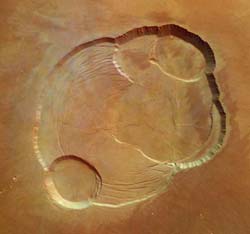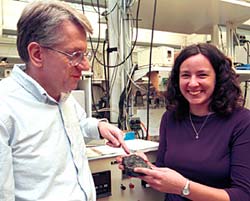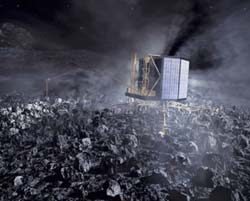This area deals with the fundamental laws and building blocks of nature and how they interact, the properties and the behavior of matter, and research into space and time and their structures.
innovations-report provides in-depth reports and articles on subjects such as astrophysics, laser technologies, nuclear, quantum, particle and solid-state physics, nanotechnologies, planetary research and findings (Mars, Venus) and developments related to the Hubble Telescope.

If comets hitting the Earth could cause ecological disasters, including extinctions of species and climate change, they could also disperse Earth-life to the most distant parts of the Galaxy.
The “splash-back” from a large comet impact could throw material containing micro-organisms out of the planet’s atmosphere, suggest scientists from Cardiff University Centre for Astrobiology.
Although some of this outflowing material might become sterilised by heat and radiation, they believ

View from overhead of the the complex caldera (summit crater) at the summit of Olympus Mons on Mars, the highest volcano in our Solar System.
Olympus Mons has an average elevation of 22 km and the caldera has a depth of about 3 km. This is the first high-resolution colour image of the complete caldera of Olympus Mons.
The image was taken from a height of 273 km during orbit 37 by the High Resolution Stereo Camera (HRSC) on ESA’s Mars Express on 21 January 2004. The view is centred

Lead sulfide — also known by its mineral name, galena — is a naturally occurring mineral found in Missouri, other parts of the world, and now … other parts of the solar system.
That’s because recent thermodynamic calculations by researchers at Washington University in St. Louis provide plausible evidence that “heavy metal snow,” which blankets the surface of upper altitude Venusian rocks, is composed of both lead and bismuth sulfides.
The findings — by Laura Schaefer, resea

Although there are numerous telescopes – both large and small – examining the night sky at any one time, the heavens are so vast and so densely populated with all manner of exotic objects that it is extremely easy to overlook a significant random event. Fortunately, a new generation of scientific instruments is now enabling UK astronomers to prepare for the unexpected and become leaders in so-called “Time Domain Astrophysics”.
Exciting new observations of many different, time-variable celest

ESA PR 08-2004. With just 21 days to the launch of the European Space Agency’s Rosetta comet mission, the spacecraft’s lander has been named “Philae”. Rosetta embarks on a 10-year journey to Comet 67P/Churyumov-Gerasimenko from Kourou, French Guiana, on 26 February.
Philae is the island in the river Nile on which an obelisk was found that had a bilingual inscription including the names of Cleopatra and Ptolemy in Egyptian hieroglyphs. This provided the French historian Jean-Franço

Dutch researcher Arjan Lock has investigated the behaviour of vibrating water molecules. Using ultra-short laser pulses, he found that hydrogen atoms in water molecules vibrate for longer at higher temperatures. This is abnormal because in the majority of substances a vibration lives shorter at higher temperatures.
Lock studied the OH-stretch vibration in water. He found that the lifetime of the OH-stretch vibration, a vibration of a hydrogen atom with respect to the oxygen atom, is extremel